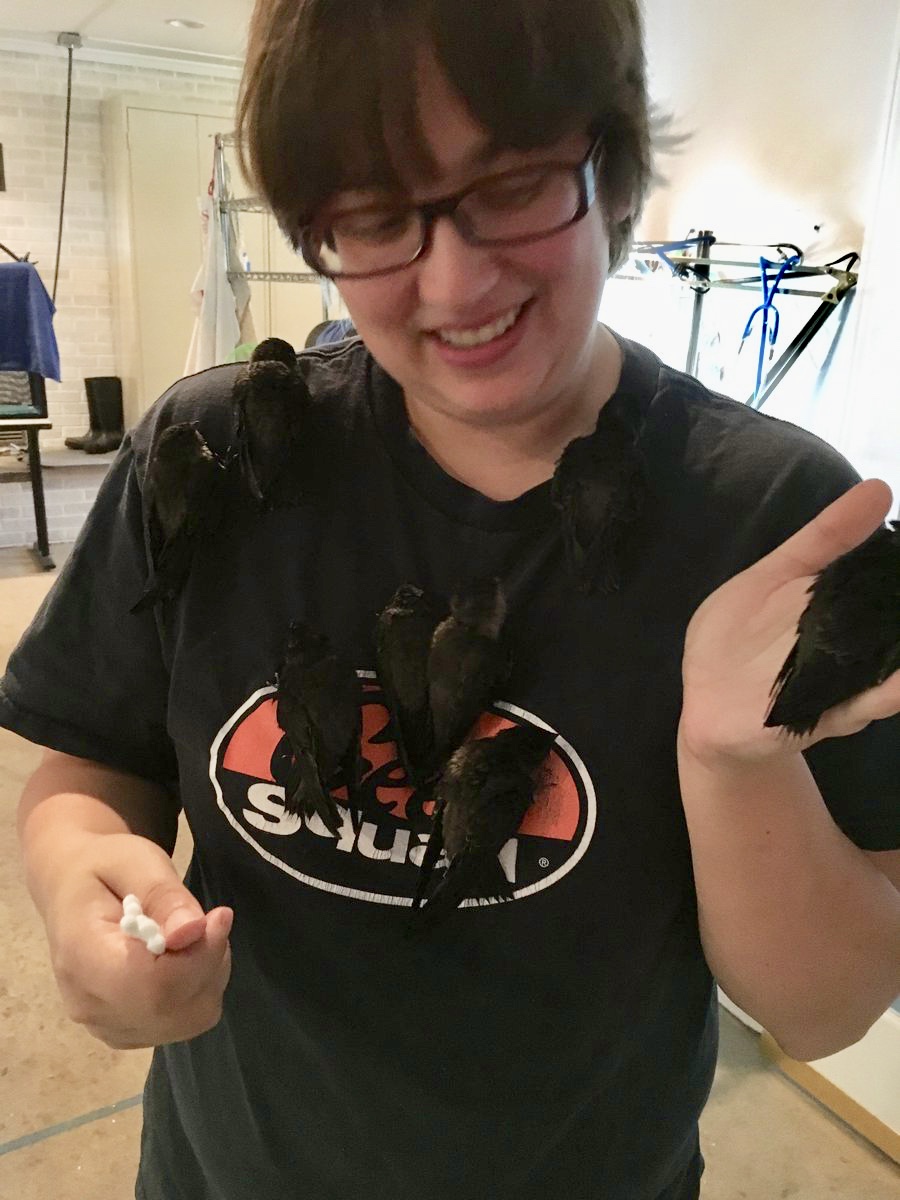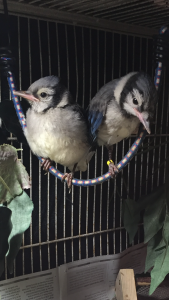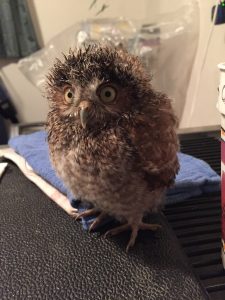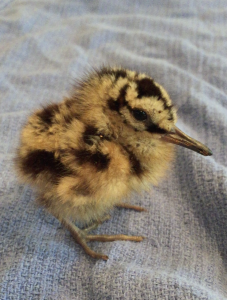By Ashley Peele

Haley Olsen-Hodges holding Chimney Swift nestlings
The increasing range and diversity of people who make up the birding community is encouraging to those of us who work with them. For some, birding is a hobby, an outlet for connecting to the natural world and contributing to conservation efforts. Many of the Atlas volunteers featured in these articles are exceptional in their commitment to birding for conservation. For others, working with wildlife is a calling, a lifelong avocation to work with and for wildlife. The last Atlas volunteer story featured a student who is just starting out in the world of bird conservation research. This time, we turn our focus to a recent graduate who has dedicated her career to a different side of wildlife conservation, the field of rehabilitation. Through this work, she is making her own unique and exceptional contribution to the VABBA2 project.
When did your love of birds and birding begin?
“I’ve always loved birds and have had a special place for them in my heart even before I could speak. As a baby living in Japan I was fascinated by the pigeons in the parks of Tokyo and my parents said I would smile widely every time I saw one. I’ve been birding casually all my life, but I only started listing and recording what I saw in 2008. I became an eBird user in 2013 when I became more serious about the hobby.”
How did you get your start in wildlife rehabilitation?

Blue Jay fledglings (Haley Olsen-Hodges)
“I was in high school when I started doing wildlife
rehabilitation, as a volunteer at the Wildlife in Need Center in Oconomowoc, Wisconsin. There, I trained to care for young songbirds in the baby bird ward of the center. Over the course of my first summer, I volunteered so much that when I asked to become a regular volunteer during the school year, I was allowed
to making me the only volunteer under 18 for quite some time. Due to my age and legal regulations, I was limited as to what animals I could work with, but I gained experience for a collective total of four years and was trusted enough to train incoming college interns and new volunteers on proper baby bird care. I also gained subsequent experience as a volunteer at Wildlife Care Clinic in Iowa and the Florida Wildlife Hospital and Sanctuary.”
What drew you to this branch of wildlife conservation work?
“The field of wildlife rehabilitation is both a heartwarming and heartbreaking one. I’ve gotten to experience wondrous things, such as releasing a Gray-cheeked Thrush with

Eastern Screech Owl fledgling (Haley Olsen-Hodges)
my own hand that I had cared for all winter after it had missed migration due to an injury. I’ve been mesmerized by fledgling American Goldfinches engaging in play behavior with a discarded feather, and cared for an albino American Robin. And I’ve also experienced awful things, like caring for a sickly fledgling Tree Swallow for three days straight and putting everything into saving that bird only to have it die. Witnessing helpless nestlings coming in infested with maggots or a frostbitten Cooper’s Hawk making direct eye contact with me before seizing up, giving one last screech with wings outstretched and dying.
I am very lucky to be working at Southwest Virginia Wildlife Center of Roanoke (SVWC), one of the only legal veterinary wildlife hospitals in Virginia and one of the largest centers by the number of patients admitted annually. Even on the difficult days I count my blessings that I’m able to do work I love with creatures that I love. The center has allowed me to both broaden and hone my skills further. I’m really interested in how conservation science, wildlife rehabilitation, and the birding community can all better serve each other in terms of data gathering and research. I hope to focus my career on building that bridge. Currently, among my many duties, I’m in the process of writing standardized rehabilitation care protocol for every species of bird found throughout Virginia, based on available research on each species, and am learning a lot in the process.”

Scarlet Tanager (Haley Olsen-Hodges)
Contributing to the Atlas project…
Haley is a member of the New River Valley Bird Club and can frequently be found birding in southwest VA, during the fall and winter. However, the breeding season (spring and summer) is not only the busiest time of the year for wildlife, but also for wildlife rehabbers. As the weather warms and animal activity levels increase, their risk of running afoul of human activity also increases. Foreseeing this challenge to participation the Atlas project, Haley decided to utilize the information that Southwest Virginia Wildlife Center collects throughout the breeding season…
“After spending all day rushing around to provide time sensitive care for hundreds of animals, I don’t have a lot of energy to do traditional Atlasing during my free time. However, the center receives physical evidence of breeding birds all the time and I realized there was good data being wasted. Last year, data from our center contributed to Atlas datasets for 36 counties and 53 species, and although I haven’t started entering data for this year into eBird, several new counties and species will be added to that total.”
Haley worked with the VABBA2 director to lay out a methodology that adapts standard Atlas data collection methods to work with the type of breeding evidence collected by the SWVC. Fortunately, the center already required people to report exact locations and dates that injured wildlife was found and collected. As a result, Haley has made a significant contribution to the Atlas project, despite getting little field time in Spring and Summer.

American Woodcock nestling (Haley Olsen-Hodges)
What advice would you give to other birders?
“Get creative with ways to help the Atlas! If you don’t have the ability or skill to do traditional Atlasing, then there are still ways to help. If your neighbors or friends have nest boxes, but aren’t eBird users ask if you can inspect them to gather data for them. If you see a photo on social media about someone taking a picture of a young fledgling or breeding behavior, send them a message, explain the project, and offer to record the sighting, if they will provide you with more information. Volunteer to input data from non-eBird using birders into VABBA2 for them. Above all, if you see an opportunity to increase the scope of the Atlas, no matter how big or small it is, go for it!”
Given the scale of the Atlas project, creative participation by members of the birding and wildlife community is crucial. Volunteers who are willing to think outside the box, communicate, and foster participation in the Atlas project are daily increasing the capacity of the VABBA2 to successfully survey all regions of Virginia. Thanks to Haley and all of the other volunteers who are going the extra mile to generate valuable data for the VABBA2.
~Dr. Ashley Peele, State Coordinator, VA Breeding Bird Atlas (VABBA2)

